Who Was Artemis of Ephesus?

Article 2 of 5

SandraGlahn.com – Making Research Accessible
(See Dr Glahn’s new book, Nobody’s Mother: Artemis of the Ephesians in Antiquity and the New Testament)
This article is part of the series Pursuing Partnership: Men and Women in Ministry.
Artemis of the Ephesians. Most commentators refer to her as a fertility goddess. Others say, “Who cares—she has nothing to do with how we read scripture.”
But Acts 19 suggests otherwise. There we read that Paul’s gospel work in Ephesus threatened the Artemis silver workers’ trade. And in Paul’s greeting to his protégé Timothy in Ephesus, he writes, “As I urged you when I was leaving for Macedonia, stay on in Ephesus to instruct certain people not to spread false teachings.” The Artemis cult had a hold on Ephesus long before and long after Paul ministered there. So who was their goddess?
At the time of the earliest Christians, Artemis’s temple in Ephesus stood as the most preeminent of the Seven Wonders of the World. People came from all over the Roman Empire to see it.
Ancient images of the Ephesian manifestation of the goddess abound. Yet on coins and paintings that depict “Artemis of the Ephesians,” we often find an altogether unique image from that of the typical short-skirted Artemis carrying a bow. The uniquely Ephesian version is covered with animal faces, has tightly encased legs, and possesses a midriff decorated with bulbous objects. Experts disagree as to the identification of these objects, but most likely they were Hittite magic pouches. And that’s interesting, because the section of Acts about Artemis cited above is directly preceded by a story about Ephesian magic workers burning their books after they came to know Christ. Inscriptions hint that Artemis and magic were connected.
So who was this goddess? It matters little how people thought of earlier iterations of her seen as early as the 7th century BC. It also matters little how Jerome thought of her in the fourth century AD. What matters to students of the Bible is who she was at the time Paul and Timothy would have been in Ephesus. And we know from papyri, inscriptions, coins, and sculptures that Artemis of the Ephesians was especially associated with midwifery, not to be confused with mothering, nurturing, or fertility. Think obstetrician or midwife vs. the mother giving birth. Artemis was the one who “delivers.”
Next time we’ll talk about the ramifications of this characteristic. Because knowing who this goddess was helps us understand the uproar in Acts 19. And it also helps explain why Paul would encourage those in Corinth to stay single for the sake of the kingdom (1 Cor. 7:38), yet in Ephesus he would tell Timothy he wanted the young widows in his care to marry and have children (1 Tim 5:14). Are there other significant implications as well in Paul’s writings regarding the Ephesian church?
This article is submitted by Wendy Wilson of Missio Nexus and of Women’s Development Track. Women’s Development Track is a Missio Nexus member. Member organizations can provide content to the Missio Nexus website. See how by clicking here.






Responses